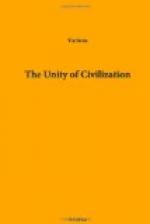* * * * *
European art still transcends nationality; in its essence it is differentiated by the personality of the artist, not by the distinction of nationality. This may seem at first sight a paradox, for you may be inclined to say that surely the modern national literatures are in many ways different, you will say that there is surely some great difference between Dutch and Italian painting, some great contrast between English and French poetry. Many people used to speak, perhaps some do still, of the warm and passionate and romantic south, and of the cold and ungracious and passionless north. But this is merely a delusion. Dante is not more imaginative or passionate than Shakespeare.
What is it then which has produced this impression? The answer to the question and the best evidence of the unity of European art will perhaps be found in examining some of the great movements in its history, since the time when the civilization of the Middle Ages reached its highest point in the thirteenth century.
With the fourteenth century we come to the beginning of a movement which culminated in the greatest literature of the modern world, in the drama of England and Spain. But its beginnings are at first sight strangely different from its fulfilment, and it is almost impossible therefore to find any phrase or term under which we can justly represent it. The first great master of the new world was Dante, but not the Dante of the exquisite sentiment but artificial form of the Vita Nuova, but the great imaginative realist of the Divine Comedy, the artist who could portray the passion and pain of Francesca and her lover, and with equal power the masterful figure of Farinata, whose dauntless soul not hell itself could quell; who could pass from the vivid drama of the fierce contemporary life of Italy to the infinite peace of those to whom ’la sua voluntade e nostra pace’. For indeed it is this which places Dante among the supreme poets of the world, that there is no aspect of the reality of human life and experience which is strange to him, and which the greatness of his imagination cannot make living to us. It has often been said that Dante is the greatest and most representative artist of the Middle Ages, but so far as this is true, and it is only partially true, it may make plain to us that there are no boundaries of time in art any more than of race or country. Dante is the first great artist of a new world, but it was not till three centuries had passed, it was not until Shakespeare, that the whole meaning of the new literature was made clear. The new literature has been thought to begin with two great artists, an Italian and an Englishman: with Boccaccio in the south and Chaucer in the north.




